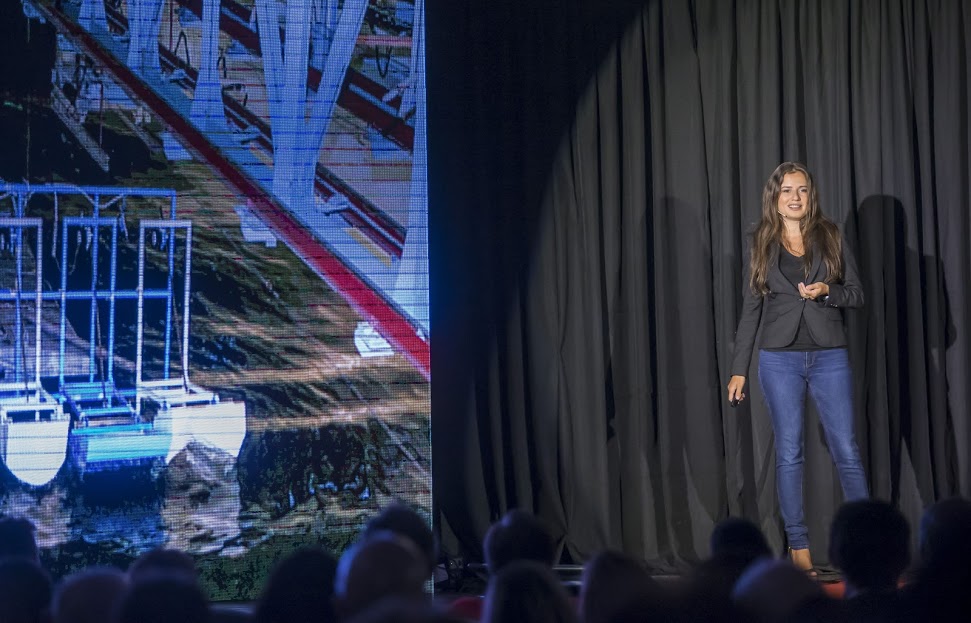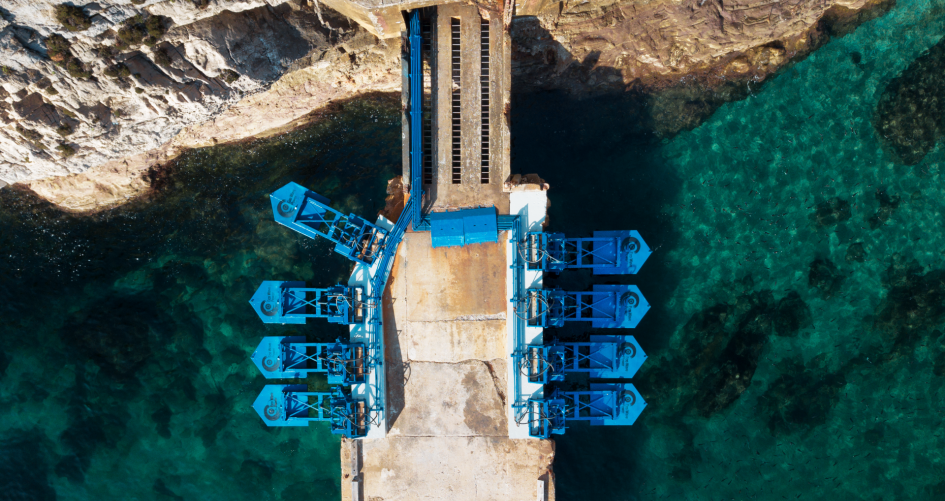While marine energy offers huge potential, many offshore projects have been hampered by cost and reliability. Yet one company’s focus on onshore wave energy might be a gamechanger.
Walk along a stretch of coastline anywhere in the world and you will most likely see a number of man-made structures jutting out to sea: piers, jetties and wave breakers –structures you probably don’t give a second thought to, but which gave a pair of entrepreneurs an idea which may help transform the world of marine energy. Eco Wave Power is a Swedish company, founded in Tel Aviv in 2011, by Inna Braverman and David Leb, who both understood the potential of ‘onshore’ marine energy.
Marine energy offers lots of advantages over other types of renewables: 71 per cent of the world is covered in water, with oceans making up 96.5 per cent of that. Ocean energy technology offers high predictability, while the density of water compared to wind means more energy can be generated. And, according to IRENA’s Director-General, Francesco La Camera, “Renewable energy from oceans has the potential to meet four times the global electricity demand of today, foster a blue economy, and bring socio-economic benefits to some of the areas most vulnerable to climate change.”
However, the vast majority of ocean energy initiatives are located offshore, which results in issues around cost, maintenance and insurance. In 2019, according to IRENA, marine energy had a total cumulative capacity of 531MW, compared to solar’s 578,553MW and wind energy’s 622,408MW. Marine energy is such a small portion of the renewables mix due to the fact that offshore projects are expensive, often unreliable (both in terms of converting enough wind to power, and with regards to energy storage) and difficult to connect to national grids.
Onshore Developments
As Eco Wave Power’s Inna Braverman says, “It took 100 years of onshore development in wind turbines before they moved offshore. Because anything offshore is much more expensive and much more difficult, the wind industry had to become stronger financially and technically before it went offshore. For some reason wave energy developers were overconfident; from day one they said let’s put something in the middle of the ocean and generate electricity.”

Above: Eco Wave Power's co-founder, Inna Braverman
Main Image: Eco Wave Power's Gibraltar power station
That caused a number of issues around cost feasibility. “When you go offshore you need ships and divers and different cables and moorings, and [as a result] the price goes sky high,” Braverman says. “The second issue is the reliability and breakability of those systems, as offshore you have 20-metre-high waves, and not many things can survive that. So, insurers won’t insure these systems due to high prices and low reliability. And the environmentalists who were supposed to be the greatest supporters of wave energy object because it creates a new presence on the ocean floor and disturbs the marine environment.”
Eco Wave Power (a former Global Climate Action award winner) sidesteps these issues by using existing man-made structures such as piers, jetties and breakwaters, to attach ‘floaters’ to. The floaters convert the rising and falling motion of the waves by compressing and decompressing hydraulic pistons which transmit a biodegradable hydraulic fluid into accumulators. These then rotate a hydraulic motor, which in turns rotates a generator and the electricity produced is then transferred into the grid. The hydraulic fluid, after decompression, flows back into the hydraulic fluid tank, where it is then re-used by the pistons, thus creating a closed circular system. The beauty of the system is that it is fully modular and scalable, and relatively easy to build and operate.
Connecting to the Grid
Of course, the devil is in the detail, and it took a number of years for Eco Wave Power to turn their idea into reality. “It took a very long time to get from the idea to finished prototype as neither David nor I are engineers,” Braverman says. “We started with an idea with sketches and blueprints, held a competition for 300 engineers and ended up choosing five to build it. We tested many different floater shapes in a wave pool to see how the shape of the floaters influenced the absorption of the power from the waves.”
In 2016, they received approval to build the first grid-connected wave energy system in Gibraltar. “We discovered we could safely connect to the grid, and that our storm protection mechanism works. This prevents the system from breaking when the waves are too high. The floaters automatically rise into an upward position (above the waves) and stay that way until the conditions are better.”
Eco Wave Power will soon generate 15 per cent of Gibraltar’s energy supply, a huge milestone, and one that can be used as a template for future projects. And Braverman is clear on what her future goals are. “Our next step is to start building bigger power plants and to commercialize our product. But my dream is that in the future, any time a breakwater is a built, wave power technology is added to it, so the breakwater can start producing clean electricity. If that happens, we might see wave power catch up with, or even bypass solar and wind power.”
Marine Energy Solutions
Ocean Thermal
Ocean Thermal Energy Conversion uses the temperature differences between the upper surface layer of the sea and the colder water up to 1,000 metres deep to generate power. The plus of this type of technology is that it can provide electricity on a continuous basis. The challenges include the fact that it requires large seawater pumps, large piping systems and cold-water pipes which need to operate in hostile environments out at sea.
Tidal Current
Tidal energy technology is not new: tidal mills for example, were found in Europe from around the year 700. Modern tidal energy projects started in the 1960s, although very few are actually operational. Turbines are placed in tidal streams which generate electricity – and due to the fact water is denser than air, and the tides are more reliable than wind – a steady, reliable stream of electricity is produced.
Tidal Range
Tidal range systems use the same principles as hydropower and require a large dam – called a barrage – to impound a body of water, through which water is forced through turbines, creating energy. There are environmental issues around this type of technology, as the change in water level and salinity in the lagoon can harm sea life, while the costs are also significant.
Salinity Gradient
This type of technology harvests energy from the difference in salt concentration between seawater and fresh water, where the change in ‘osmotic pressure’ is turned into a source of energy. The most advanced salinity gradient technology is called Reverse ElectroDialysis (RED), which is more cost-effective than previous technologies.
